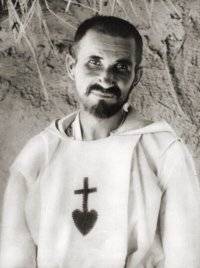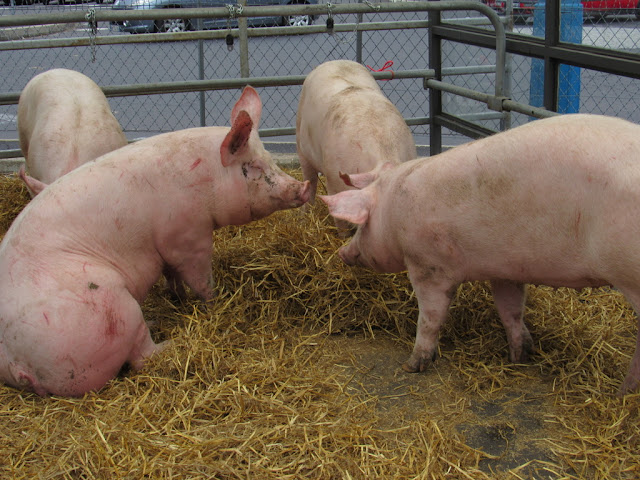It was a cold, rainy, windy day, but we took time off from the Centre to spend time at the Abbey of Notre Dame de la Neige, about 90 minutes from Le Puy. Snaking through the mountainous French countryside proved to be a great adventure despite the bad weather. The smooth two-lane highways; the gorgeous, green-clad farms sectioned off by stone fences, some with brown-spotted cows; and the white, blossoms of various fruit trees gave way to colorful rocky outcroppings in the mountains that were made more beautiful by the rain.


 |
| entrance to the Abbey |
Notre Dame de la Neige is a Trappist (Cistercian) abbey that was founded in 1850 and became a reality with the first of its three buildings in 1874.
Our Day at the Abbey
We joined the monks at Mass in the simple but inspiring chapel where there was chanting, incense, and prolonged silent periods. The monks sat in the front of the chapel in traditional, wooden monastic stalls that faced the center aisle. The rest of us looked forward at the altar and sat in creaky wooden pews.
 After the Mass we looked around for other life and discovered a building which housed the monks and the retreatants. A man on retreat let us into the building. Then, one of the monks, who was dressed in a long white robe with a black surplice, allowed us to use the small dining room for our lunch.
After the Mass we looked around for other life and discovered a building which housed the monks and the retreatants. A man on retreat let us into the building. Then, one of the monks, who was dressed in a long white robe with a black surplice, allowed us to use the small dining room for our lunch. 
Eluiza and I had brought a picnic lunch of sandwiches, fruit, and brownies since we didn't know if any restaurants would be open in the area. Typically, the French close their businesses on Sunday and spend the day with their families. We felt very privileged to be there!
The monk also told us that the gift shop, museum, and 25-minute film about the abbey would open at 2 p.m. After lunch we decided to spend the next 90 minutes in a small town seven kilometers from the abbey, St. Laurent les Bains. The town had an old castle on its summit.
This beautiful little town was tucked away in a valley, which hosted a hot springs. I made a mental note to return here to experience them; I love hot springs!
We also found a small, family restaurant that was open. It appeared that the husband and daughter cooked the French country-style food and the mother and another daughter served it. The steaming dishes heaped with stewed meats and vegetables looked very good as they were transported from the kitchen near where we sat to the diners' tables. This was yet another reason to return to this town.
 I had planned to have just a coffee, but noticed the French fries (les frites) that other diners had ordered. They looked too good to resist. Eluiza had her favorite dessert, creme brulé. We both found satisfaction in our choices!
I had planned to have just a coffee, but noticed the French fries (les frites) that other diners had ordered. They looked too good to resist. Eluiza had her favorite dessert, creme brulé. We both found satisfaction in our choices!
 We returned to the Abbey only to be in another rainy downpour, but managed to find the bookstore. It had some wonderful books about the Abbey, the lives of the monks, and medieval life as well, which has lately been a great fascination for me. I purchased two books (in simple French): one on the medieval monks and the other on the medieval knights in armor. Also available were healing herbal medicines the monks had made as well as jams and beer. A volunteer layman served as the cashier at the store.
We returned to the Abbey only to be in another rainy downpour, but managed to find the bookstore. It had some wonderful books about the Abbey, the lives of the monks, and medieval life as well, which has lately been a great fascination for me. I purchased two books (in simple French): one on the medieval monks and the other on the medieval knights in armor. Also available were healing herbal medicines the monks had made as well as jams and beer. A volunteer layman served as the cashier at the store. We saw some hikers (randonneurs) and pilgrims at the abbey, which welcomes them with accommodations as part of the monks' ministry. The hikers were walking with a couple donkeys (reminiscent of Robert Louis Stevenson's book, Travels with a Donkey in the Cévennes.) that later grazed on the grass outside the abbey's museum.

We explored the small, outdoor chapel and were captivated by its simplicity and welcoming ambience.
 We missed about half of the film, but saw enough of it to get a taste of the monks' life at the Abbey. What was really interesting was the museum that featured the life of Br. Charles Foucault, who had entered the Trappists through this Abbey. Prior to his entrance, he was a military officer in Algeria.
We missed about half of the film, but saw enough of it to get a taste of the monks' life at the Abbey. What was really interesting was the museum that featured the life of Br. Charles Foucault, who had entered the Trappists through this Abbey. Prior to his entrance, he was a military officer in Algeria.Here are some of his personal items.
Brother Charles and a couple others have passed through this abbey to make it a famous stopping point for pilgrims and tourists alike. Here are their brief bios.
 Brother Charles Foucault, entered the order here in 1890. The former French Army officer had developed strong feelings about the desert and solitude during his assignments in Algeria. He later returned there to live and minister to the Tuareg people. He was assassinated in 1916 and considered by the Catholic Church to be a martyr. His inspiration and writings led to the founding of the Little Brothers of Jesus and he was beatified on November 13, 2005 by Pope Benedict XVI.
Brother Charles Foucault, entered the order here in 1890. The former French Army officer had developed strong feelings about the desert and solitude during his assignments in Algeria. He later returned there to live and minister to the Tuareg people. He was assassinated in 1916 and considered by the Catholic Church to be a martyr. His inspiration and writings led to the founding of the Little Brothers of Jesus and he was beatified on November 13, 2005 by Pope Benedict XVI.  Robert Louis Stevenson also passed through here with his donkey, Modestine, during the autumn of 1878. He wrote about his journey in Travels with a Donkey in the Cévennes. (I'm reading it now.) The young Scottish writer who later became famous with Treasure Island and Kidnapped, chose this mountainous area because it was one of the few parts of France where Protestantism prevailed, according to Walking in France. His trek has now become a famous hiking route that starts in Le Puy and ends in Florac.
Robert Louis Stevenson also passed through here with his donkey, Modestine, during the autumn of 1878. He wrote about his journey in Travels with a Donkey in the Cévennes. (I'm reading it now.) The young Scottish writer who later became famous with Treasure Island and Kidnapped, chose this mountainous area because it was one of the few parts of France where Protestantism prevailed, according to Walking in France. His trek has now become a famous hiking route that starts in Le Puy and ends in Florac. He liked walking because "you must have your own pace, and neither trot alongside a champion walker, nor mince in time with a girl." Walking helped him "surrender himself to that fine intoxication that comes from much motion in the open air, that begins in a sort of dazzle and sluggishness in the brain, and ends in a peace that passes comprehension."
 Robert Schuman, a French statesman and two-time prime minister, also has a connection with Notre Dame de la Neige: he hid from the Nazis here during World War II. Although he was a minister with the first Pétain government in charge of refugees, he refused to continue because he objected to Nazi methods. He was arrested for these acts and almost ended up in Dachau. Instead he became a personal prisoner of Nazi party leader Joseph Buerckel, from whom he escaped in 1942. He then joined the French Resistance and continued speaking about the need for European reconciliation that must take place after the war, as he had done before the war. Schuman later helped re-build post-war Europe and was one of the founders of NATO, the Council of Europe, and the European Union.
Robert Schuman, a French statesman and two-time prime minister, also has a connection with Notre Dame de la Neige: he hid from the Nazis here during World War II. Although he was a minister with the first Pétain government in charge of refugees, he refused to continue because he objected to Nazi methods. He was arrested for these acts and almost ended up in Dachau. Instead he became a personal prisoner of Nazi party leader Joseph Buerckel, from whom he escaped in 1942. He then joined the French Resistance and continued speaking about the need for European reconciliation that must take place after the war, as he had done before the war. Schuman later helped re-build post-war Europe and was one of the founders of NATO, the Council of Europe, and the European Union.
###
On our way back to Le Puy, we saw this beautiful scene of a bridge over the Allier River (a tributary that flows into the Loire River) with the mountains in the background. It had been an awe-inspiring day!
 |


































